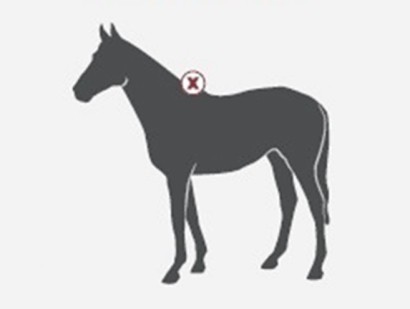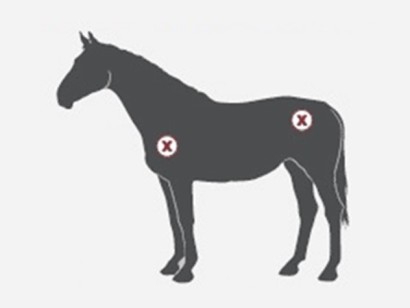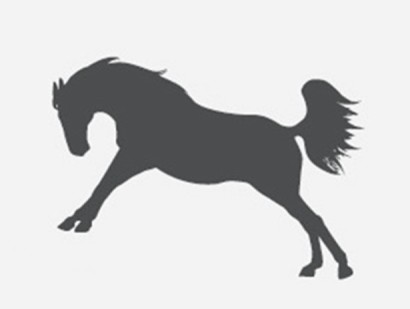How to Measure a Horse for a Blanket
Updated September 22, 2025
Wrapping your horse in a well-fitting blanket is like hugging him, even when you’re not there. Finding the perfect fit starts with knowing your horse’s size.

Steps for Measuring a Horse for a Blanket
Follow these instructions and tips to properly measure your horse for a blanket:
- Start by placing the cloth tape measure at the center of your horse’s chest.
- Run the tape measure along his side, including the widest part of his shoulder while keeping the tape measure level and taut (it is easiest to have a friend help you!).
- The measurement ends once you have reached the point of the buttocks (where the “cheek" meets the tail).
- This number of inches is your horse’s true size.
When shopping for your horse’s blanket size, note that some brands run a little large or small, so we recommend checking out the hundreds of product reviews left by horse owners like you!
Video on How to Measure a Horse for a Blanket
Evaluating Your Horse’s Blanket Fit and Size
A well-fitting blanket will keep your horse warm and comfortable, but an ill-fitting blanket can restrict movement, cause rubs, shift, or get tangled. Test the blanket’s fit by watching your horse walk and graze in it. These natural movements will highlight potential flaws in the fit.
Pay attention to these three key areas when fitting a horse blanket:

- A: Shoulders - The top of the front closure should line up with the point of your horse’s shoulder. The neckline should lie smoothly above his shoulder without pulling.
- B: Withers - A blanket that’s pulled tight across your horse’s withers is a recipe for rubs. You should be able to slide one hand between the blanket and your horse’s withers.
- C: Length - A blanket shouldn’t look like a mini skirt or a bed skirt. Ideally your horse’s blanket should cover your horse’s barrel entirely, ending just below his elbow and stifle.
Blanketing Fit Problem Solvers
Horses come in all shapes and sizes, and blankets come with many different cuts, features and styles, so getting a blanket that matches your horse’s needs is key. As a company full of riders and horse owners, we have plenty of experience finding the right blankets, whether it’s for our own horses or for other riders like you.
Since we know it can be tricky to know which blanket will have the right features for your horse, we’ve identified the most common issues we hear about and how to fix them. Whatever you’re battling–whether it’s shoulder rubs, wither woes, or finding a neck style that's right for your horse–we’re here to help!

What you're seeing: Your horse is a well-muscled Quarter Horse, Paint, or other stock horse breed. Due to your horse’s body type, some blankets fit too snugly in the chest, shoulders, hindquarters, and withers. In addition, you may find that some blankets hang too low.
Look for: Blanket styles that are cut for a Quarter Horse-type build, like Stocky Fit by SmartEquine. You’ll want features such as:
- Cut back wither: A cut back wither will help take the pressure of your horse’s wither area, preventing uncomfortable rubs.
- Broader fit: Some blankets are designed with a broader fit through the chest, shoulders, and hindquarters to accommodate stock horses.
- Shorter drop: If you find that standard cut blankets are too long on your stock horse, look for a blanket that’s designed to have a shorter drop.
Shop Top Picks For Quarter Horse Types

What you're seeing: Your horse has high withers, and traditionally cut blankets put too much pressure on them, leading to discomfort and rubs. You may also notice that they don’t fit properly around your horse’s neck, causing a gap in between the blanket and your horse’s body that lets in cold air, rain, and snow.
Look for: Blankets that feature extra padding at the withers or a higher neck style. When you’re shopping, look for the following features:
- High Neck: A high neck design reduces pressure on the withers and offers better protection from the elements.
- Combo Neck: Like a high neck, a combo neck helps reduce pressure on the withers. Plus, it offers poll-to-tail coverage to prevent any rain, snow, or wind from reaching your horse.
- Wither Relief: Padding at the withers can help lift the blanket off the wither to reduce the risk of rubbing.
Shop Top Picks For High Withers

What you're seeing: Your horse is a full-bodied Warmblood type or a larger breed. Due to your horse’s size and shape, some blankets fit too snugly in the shoulders and hips. This causes pressure points that lead to uncomfortable rubs, especially when your horse is moving around.
Look for: Blanket styles that are cut for bigger, well-muscled horses, designed with features like:
- Gussets: Gussets are extra pieces of fabric sewn into the blanket to allow for a more generous fit and a greater range of motion. While you’ll most commonly see gussets at the shoulders, you can also find blankets with gussets at the hind legs.
- V-front closure: Blankets with a V-front are cut a little higher over the shoulder and neck and come together lower on the chest, helping eliminate some of the traditional pressure points.
Shop Top Picks For Big-Bodied Warmblood-Types

What you're seeing: Your horse is tough on his blankets or gets turned out with other horses, and his blankets frequently get rips and tears.
Look for: Consider choosing a blanket that’s backed by a guarantee, and consider the following features that impact a blanket’s toughness:
- Denier: Denier, which is the measure of nylon fiber density, is the most common way to rate the strength of a blanket. A higher denier indicates that a blanket is stronger than a blanket of a lower denier. That’s why when you have a horse that’s notorious for being tough on blankets, the higher denier you get, the better!
- Weave: The weave of the blanket refers to how the fibers of the blanket material are woven together, including how tightly they’re woven and what pattern they’re woven in. Two durable weaves to look for include the ripstop weave, which helps prevent rips from spreading when they start, and the ballistic weave, which was originally developed for use in bulletproof vests.
- Fabric: Sheets and blankets are most commonly made from nylon, polyester, a combination of nylon and polyester, or polypropylene. Nylon and polypropylene are both stronger than polyester, so consider blankets with outer shells made from either of those materials.
Shop Top Picks For Blanket Shredders
To learn more about types of blankets, cleaning and folding them, their pieces and parts, and much more, visit our horse blanketing guide for everything horse owners need to know to keep their horse comfortable all winter long.